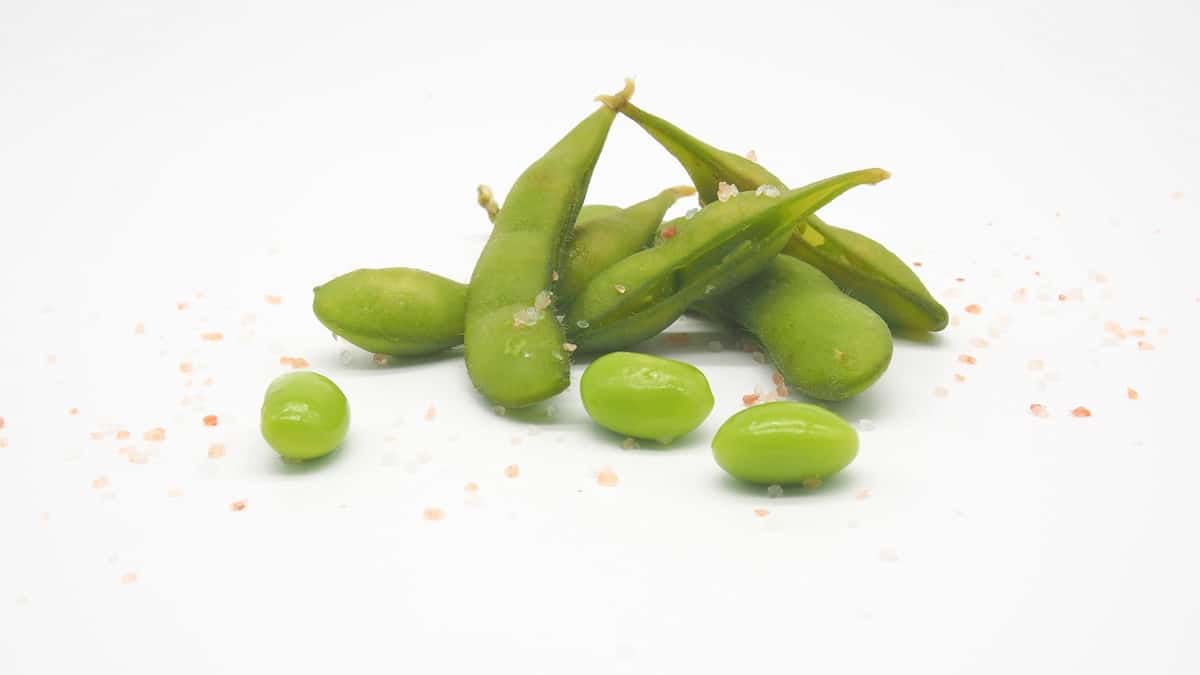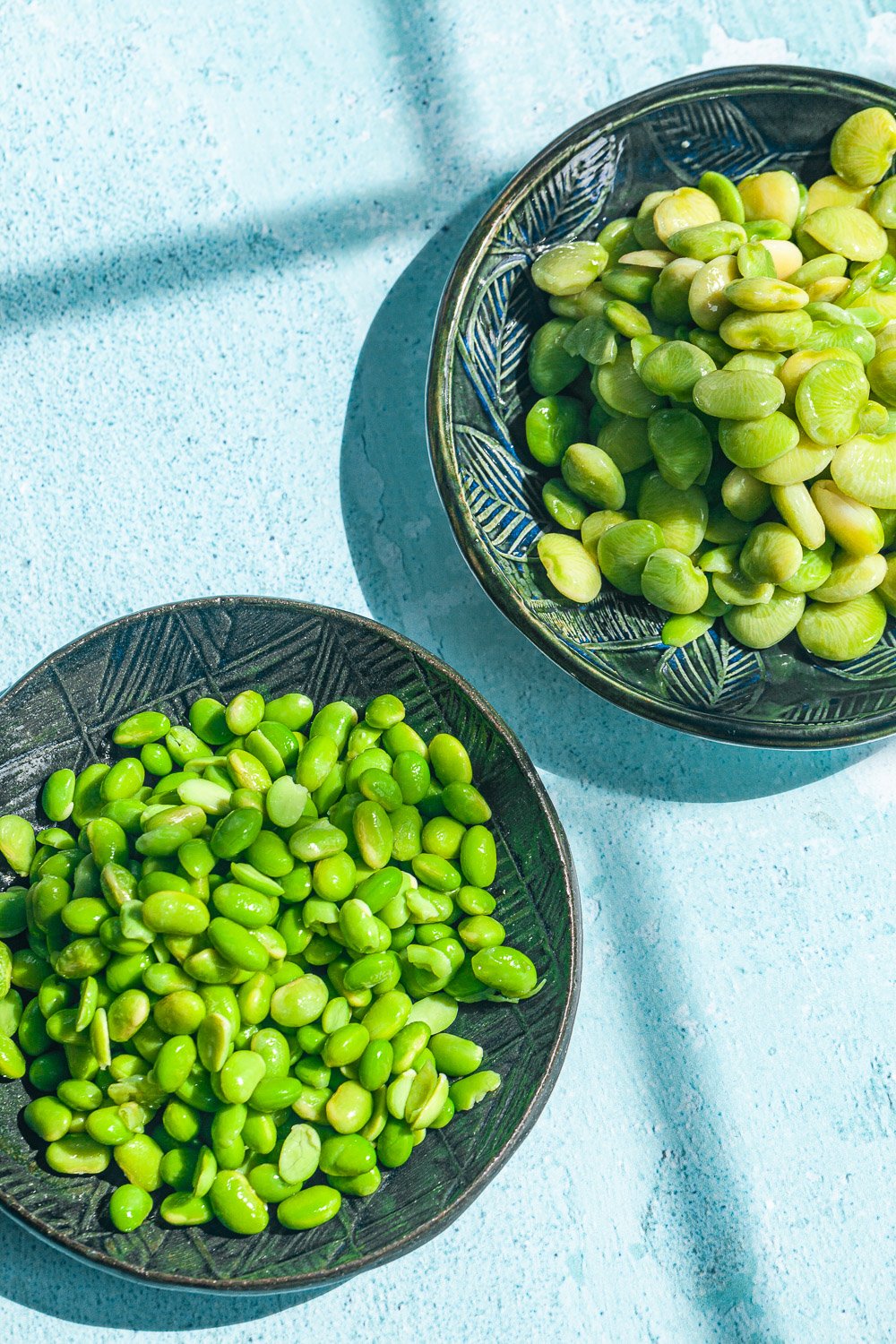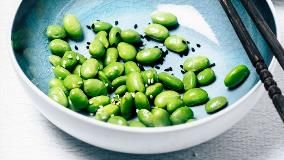What Is Edamame And Mukimame?

Edamame and Mukimame are both popular snacks made from soybeans. Edamame refers to immature soybeans that are still in their pods. These pods are typically boiled or steamed and seasoned with salt, making them a delicious and nutritious appetizer. On the other hand, Mukimame refers to the shelled soybeans. These beans are often used in various dishes, such as salads, stir-fries, or added to soups. Both Edamame and Mukimame are known for their high protein content and are considered a nutritious and wholesome snack option.
Overview Of Edamame
Edamame is a popular soybean variety that is harvested when the beans are still young and green. These immature soybeans are packed with nutrients and have a delightful sweet and slightly nutty flavor. Edamame is usually served as a snack or side dish, either boiled or steamed and lightly seasoned with salt. It is a versatile ingredient that can also be added to salads, stir-fries, and even used to make dips and spreads. Edamame is not only delicious but also a nutritious choice, as it contains a good amount of protein, fiber, vitamins, and minerals.
Overview Of Mukimame
Mukimame is another soybean variety that is often confused with edamame. Unlike edamame, which is harvested when the beans are still young and green, mukimame is allowed to mature on the plant before being harvested. This results in a slightly different flavor and texture compared to edamame. The mature soybeans have a firmer texture and a more pronounced nutty flavor. Mukimame is usually consumed as a snack or added to dishes like soups, stews, and salads. Its nutritional profile is similar to that of edamame, making it a healthy and delicious addition to any meal.
Nutritional Value Of Edamame And Mukimame

Edamame and Mukimame are both packed with essential nutrients that contribute to their health benefits. Both soybean snacks are excellent sources of protein, fiber, and healthy fats. They are also rich in vitamins and minerals, including iron, calcium, and vitamin K. Edamame and Mukimame are low in calories and contain no cholesterol or trans fats. These snacks are also gluten-free, making them suitable for individuals with gluten sensitivities or celiac disease. Incorporating Edamame or Mukimame into your diet can provide a nutritious boost and contribute to overall health and well-being.
Comparing Nutritional Content Of Edamame
Edamame is a powerhouse of nutrients, offering a wide range of health benefits. In terms of nutritional content, edamame is packed with protein, fiber, and healthy fats. A 1-cup serving of edamame provides approximately 17 grams of protein, making it an excellent plant-based protein source. It also contains around 8 grams of dietary fiber, aiding in digestion and promoting fullness. Edamame is also rich in vitamins and minerals like iron, calcium, and vitamin K. Additionally, it is low in calories and contains no cholesterol or trans fats. Incorporating edamame into your diet can be a great way to boost your nutrient intake and support overall health.
Comparing Nutritional Content Of Mukimame
Mukimame, like its counterpart edamame, is a nutrient-rich legume that offers numerous health benefits. In terms of nutritional content, mukimame is also a good source of protein, fiber, and healthy fats. A 1-cup serving of mukimame provides around 22 grams of protein, making it an excellent plant-based protein option. It is also high in dietary fiber, with approximately 10 grams per serving, promoting digestive health and supporting weight management. Additionally, mukimame contains essential vitamins and minerals such as iron, calcium, and vitamin K. Incorporating mukimame into your diet can be a great way to boost your nutrient intake and support overall well-being.
Health Benefits Of Edamame And Mukimame

Edamame and mukimame both offer a multitude of health benefits. These nutrient-packed legumes are an excellent source of protein, fiber, and essential vitamins and minerals. Incorporating edamame and mukimame into your diet can support heart health, aid in weight management, and promote a healthy digestive system. They are also known for their antioxidant properties, which can help protect against oxidative stress and inflammation. Furthermore, the high protein content of edamame and mukimame can provide sustained energy and contribute to muscle growth and repair. Adding these beans to your meals can be a delicious and nutritious way to support your overall well-being.
Health Benefits Of Consuming Edamame
Edamame is a powerhouse of nutrients, making it a beneficial addition to your diet. One of its key health benefits is its high protein content, which is important for muscle growth and repair. Additionally, edamame is rich in fiber, which aids in digestion and promotes a healthy gut. It also contains essential vitamins and minerals like folate, vitamin K, and iron. These nutrients support heart health, bone health, and the immune system. Edamame is also low in calories and fat, making it a great option for weight management. Incorporating edamame into your meals can provide a boost of nutrition and contribute to overall well-being.
Health Benefits Of Consuming Mukimame
Mukimame, similar to edamame, offers a range of health benefits when incorporated into a balanced diet. These young soybeans provide a good source of plant-based protein, making them an excellent choice for vegetarians and vegans. Protein is essential for building and repairing tissues in the body. Additionally, Mukimame is packed with dietary fiber, which aids in digestion and helps maintain a healthy weight. It also contains important vitamins and minerals, including folate, iron, and vitamin K. These nutrients support various functions in the body, such as red blood cell production, immune system function, and bone health. Incorporating Mukimame into your meals can provide a nutrient boost and contribute to overall well-being.
Culinary Uses Of Edamame And Mukimame

Edamame and Mukimame offer a versatile range of culinary uses that can elevate any dish. Both can be enjoyed as a simple snack on their own, but they also work well in various recipes. Edamame is often steamed or boiled and served with a sprinkle of salt as an appetizer. It can also be added to stir-fries, salads, and soups for an extra boost of protein and texture. Mukimame, on the other hand, is commonly used as a nutritious ingredient in veggie burgers, dips, and spreads. Its buttery texture and mild flavor make it a great addition to pasta dishes or mixed into grain bowls. Whether you’re craving a quick snack or looking to enhance your recipes, Edamame and Mukimame are versatile options that bring both taste and nutrition to the table.
Different Ways To Prepare And Serve Edamame
Edamame offers a wide range of possibilities when it comes to preparing and serving. One popular method is to steam or boil the pods until they are tender, around 5-7 minutes. Once cooked, the pods can be sprinkled with sea salt for a simple and satisfying snack. Edamame can also be added to stir-fries, salads, and soups for an extra burst of protein and texture. For a unique twist, try blending cooked edamame with garlic, lemon juice, and olive oil to create a creamy and nutritious dip. The options are endless when it comes to incorporating edamame into your culinary creations.
Different Ways To Prepare And Serve Mukimame
There are various ways to prepare and serve Mukimame, allowing you to enjoy its unique flavor and nutritional benefits in different culinary creations. One simple method is to steam or boil the pods until they are tender. Once cooked, you can sprinkle them with sea salt for a delightful snack. Mukimame can also be added to stir-fries, pasta dishes, or grain bowls for an extra dose of protein and texture. Additionally, you can blend cooked Mukimame with herbs, olive oil, and lemon juice to create a delicious and nutrient-packed spread or dip. Let your creativity flow and explore the endless possibilities of incorporating Mukimame into your meals.
Edamame Vs Mukimame: Texture And Taste

When it comes to texture and taste, Edamame and Mukimame have distinct differences. Edamame has a mild, buttery flavor with a hint of sweetness, making it a popular choice for snacking or adding to salads and stir-fries. The pods of Edamame have a firm and chewy texture, providing a satisfying crunch with each bite. On the other hand, Mukimame has a milder taste and a creamier texture. The shelled soybeans have a softer bite compared to the Edamame pods, allowing them to easily blend into spreads, dips, or soups. Whether you prefer a crunchier texture or a smoother mouthfeel, both Edamame and Mukimame offer unique sensory experiences.
Comparing Texture And Taste Of Edamame
Edamame is known for its distinct texture and taste. The pods of Edamame have a firm and chewy texture, providing a satisfying crunch with each bite. This texture adds a delightful element to various dishes such as stir-fries, salads, and even as a standalone snack. In terms of taste, Edamame has a mild, buttery flavor with a hint of sweetness. This combination of flavors makes Edamame a versatile and delicious addition to any meal. Overall, the texture and taste of Edamame add depth and satisfaction to dishes, making it a popular choice among soybean enthusiasts.
Comparing Texture And Taste Of Mukimame
Mukimame, also known as shelled edamame, has a distinct texture and taste that sets it apart from its whole pod counterpart. The texture of mukimame is creamier and softer compared to the firmer and chewier texture of edamame pods. When it comes to taste, mukimame has a milder flavor with subtle nutty undertones. This makes it a versatile ingredient that can easily absorb the flavors of other ingredients in various dishes. Whether added to soups, stews, or stir-fries, mukimame adds a creamy and slightly nutty element that enhances the overall taste and texture of the dish. So, if you prefer a softer texture and a milder taste, mukimame is an excellent choice to experiment with in your culinary creations.
Conclusion

In conclusion, Edamame and Mukimame are both delicious and nutritious soybean varieties with their own unique characteristics. Edamame is known for its sweet and delicate flavor, while Mukimame has a nuttier taste. They offer various health benefits, including being rich in protein, fiber, and essential nutrients. Edamame is often enjoyed as a snack or added to salads, stir-fries, and sushi, while Mukimame is a versatile ingredient that can be used in soups, stews, and as a topping for various dishes. Whichever variety you choose, incorporating these soybeans into your diet can be a flavorful and nutritious addition. So, don’t hesitate to give Edamame and Mukimame a try and explore their culinary possibilities.
Key Differences Between Edamame And Mukimame
Edamame and Mukimame may both be soybean-based snacks, but there are several key differences that set them apart.
- Preparation: Edamame is typically harvested when the soybeans are still young and tender, while Mukimame is harvested when the soybeans are fully matured and have hardened in their pods.
- Texture: Edamame has a softer texture with a slight crunch, while Mukimame has a firmer texture and a slightly nutty taste.
- Flavor: Edamame has a sweet and delicate flavor, while Mukimame has a more robust and nuttier taste.
- Culinary Uses: Edamame is commonly enjoyed steamed or boiled and served as a snack or added to salads, stir-fries, and sushi. Mukimame, on the other hand, is often used in soups, stews, and as a topping for various dishes.
Overall, while both Edamame and Mukimame offer nutritious benefits, their distinct texture and flavor profiles make them suitable for different culinary uses.
Recommended Consumption And Recipes
When it comes to consuming Edamame and Mukimame, there are no hard and fast rules. Many people enjoy snacking on both variations as they are packed with nutrients and make for a delicious and satisfying treat. It is recommended to consume Edamame and Mukimame as a part of a balanced diet, incorporating them into meals or enjoying them as a standalone snack.
There are numerous recipes that feature Edamame and Mukimame as a star ingredient. From vibrant salads and hearty stir-fries to flavorful soups and tasty dips, the possibilities are endless. Get creative in the kitchen and experiment with incorporating these soybean snacks into your favorite recipes to add a nutritional boost and unique flavors.
FAQ About Edamame Vs Mukimame: What Sets Them Apart?
Q: What is edamame?
A: Edamame refers to immature soybeans in their pods that are harvested at the peak of their ripeness.
Q: What is mukimame?
A: Mukimame is a trademarked term for shelled, ready-to-eat edamame that has been parboiled and then frozen for convenience.
Q: What is the main difference between edamame and mukimame?
A: The main difference lies in their presentation, where edamame includes the beans inside the pods, while mukimame offers only the shelled beans.
Q: Are there any nutritional differences between edamame and mukimame?
A: Both edamame and mukimame are rich in protein, fiber, and essential nutrients; however, mukimame may lose some nutrients during the processing of shelling and freezing.
Q: Can edamame be used interchangeably with mukimame in recipes?
A: Yes, both edamame and mukimame can be used interchangeably in recipes that call for soybeans; however, the texture and taste may vary slightly.
Q: Where can I find edamame and mukimame?
A: Edamame is commonly found fresh or frozen in the produce or freezer section of grocery stores, while mukimame may be available as a specifically labeled product in the frozen food aisle.

ToroGrill Canada is excited to share our one-of-a-kind and authentic South American BBQ flavors with the wonderful people of Canada. Our journey began with a passion for bringing South America’s rich and vibrant culinary traditions to a new audience, and we have been dedicated to this mission ever since. Our story is one of inspiration, hard work, and the pursuit of excellence. Every recipe, every ingredient, and every cooking technique has been carefully honed and perfected to ensure that when you take a bite of our food, you experience the true essence of South American BBQ.